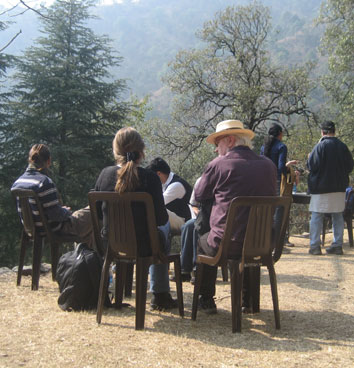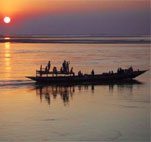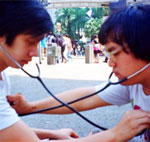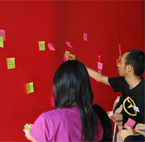chayanoot silpasart

Chayanoot is a lecturer at Bangkok university and an independent curator. In 2007 she presented Thailand's first overview of media art at Bangkok University Gallery. “From message to media” was an examination of how artists are questioning their practice in a time of technological innovation and cultural change due to globalization.
Here is a summary of her presentation:
What is media art in Thailand? What is the relevance and meaning of this term in this context? Media is an area of communications which allows a form of connection. Art itself is a process which has its own language, through all media: painting, sculpture etc. Art reflects the human need to communicate and artists likewise are not immune to social and cultural change. They are always looking for new forms of expression and New media offers potential striking new ways of expression.
There is of course the debate of New media vs traditional media and some emphasize the importance of expression of traditional method of art. However the artistic purpose should come first the intention and the lead to experimentation.
But there are many senses of new media and there is no single definition. Therefore we must question is there are particular characteristics of Asia media art and how they are different from western forms. We can expand the notion of media art to take in social and cultural differences that correspond to our own definition of the term. Thai culture not grounded in science and technology can not expect to join realms of western new media art
The language of new media presents a different interaction between individual and society and culture. We must question the relationship between art and media and the relationship of use and being used. In Thailand media art remains somewhere between the artists’ ability to manipulate their medium and an uncertainty over how the medium actually works. Thai media artists have failed to employ specific nature and full potential of their chosen medium.
The Medium should be determined by the best suited to communicate the message and context shared by the artists and others. Today's cutting edge technologies represent a wide open new avenue or alternative for artists. We are faced with a connected world in which we can question what is real and what is not and be liberated in the creation of another identity. However it is a case of distribution, of distributing the skills and resources of technology and also the creative outputs, making team work and sharing in the field of media art of great importance.
For many Thai artists, for example Dansoung Sungvornveshapan, they make use of technology in a practical way, they use it as ready-made and are not investigating the information system within it. Use of the ‘ready-made’ technology overlooks the importance of understanding fundamental development and systems which brought the technology into being. Systems for creating knowledge are separate from the consumption of this knowledge, there is no real integration, a state which needs to be challenged.
To many artists there is much convenience of media art and in Thailand is has a strong link to entertainment industry. In fact most of the media art in Thailand is produced for commercial purposes. This of course brings a set of restrictions but also advantages. Currently the independent development of media art is limited by a lack of funding and equipment and the lack of opportunities for students to explore and experiment with these forms.
In Thailand some artists are following western trends but others are responding to impact of new technologies on Thai culture and the specific context here. But here in Thailand we are not used to thinking of media art as legitimate type of visual arts, it is beyond the comprehension of majority of Thai people. Many media artists study or move abroad to pursue their activities due to the challenging climate in Thailand. Yet despite this challenge over the past 20 years an increasing number of Thai artists have taken advantage of new media to create a wide range of works Mixing of world and regional cultures and the identity of Thai artists who use new media. New media presents artists with another choice for expressing their individual selves in a manner that is connected with the rapidly accelerating pace of modern life. Artists are looking for new alternatives for interactions and movements that lie beyond the traditional borders.
From Message to Media presented the works of 10 Thai artists produced between 1985-2005. These artists are Amrit CHUSUWAN(อำมฤทธิ์ ชูสุวรรณ), Kamol PHAOSAVASDI(กมล เผ่าสวัสดิ์), Wit PIMKANCHANAPONG(วิชญ์ พิมพ์กาญจนพงศ์), Apinan POSHYANANDA(อภินันท์ โปษยานนท์), Araya RASDAMREONSOOK(อารยา ราษฎร์จำเริญสุข), Porntaweesak RIMSAKUL(พรทวีศักดิ์ ริมสกุล), Michael SHAOWANASAI(ไมเคิล เชาวนาศัย), Vasan SITTHIKET(วสันต์ สิทธิเขตต์), Manit SRIWANICHPOOM(มานิต ศรีวานิชภูมิ), Sungvorn SUNGVORNVESHAPAN
http://fab.bu.ac.th/buggallery/BUG/eCatalogueMessagetoMedia.pdf
Please find the biographies of some of the participating artists below. This text is taken from the catalogue.
 |
Kamol Phaosawasdi : : : Mode of Moral Being 1996 : : : Video Installation
Kamol Phaosawasdi received his Bachelor’s degree from Faculty of Art Education, Chulalongkorn University, and his M.F.A from Otis/Parsons Art Institute (Intermedia), California, U.S.A. in 1984. His first experience with video art was while studying his Master’s degree. Phaosawasdi always tried to use various media and styles to express his work and desires. This enabled him to experiment in his works of art with various techniques in numerous media, such as sculpture, performance, installation and also mixtures of media, before concentrating more seriously, in the next decade, on making time-based media. At that time, filming development was easier in production lines; this led to the invention of a smaller Camcorder, which could be carried around easily. In 1996, with the support of a research grant from the Japan Foundation, Phaosawasdi spent three months with a Japanese artist doing environmental research along a 138 km. distance from the Tama River to the Gulf of Tokyo, and presented the results as a video installation exhibited at the Japan Foundation, Bangkok. In the same year, Phaosawasdi set up another project called “Mode of Moral Being 1996”. This project documented the dialogs and data of Pathpong bar girls, focusing on the reasons for entering prostitution voluntarily. In this project, Phaosawasdi presented his artwork in a form between installation and video sculpture, and finally exhibited it in New York. Phaosawasdi continues to work in video sculpture/installation art, time-based media and many other media. Nowadays, he is an Associate Professor in the Faculty of Fine Arts at Chulalongkorn University.
|

|
Porntaweesak Rimsakul
: : :
Flower Bed 2004
: : : Video Installation
Porntaweesak Rimsakul received his B.F.A in visual arts from Bangkok University in 2002 and M.F.A from the Faculty of Painting, Sculpture and Graphic Art, Silpakorn University in 2005. The main concern of his work mostly signifies characteristics, forms and objects’ meaning. He has chosen objects that are relevant to his own experiences in daily life. Accordingly, Rimsakul evoked pairs of objects with his imagination and represented them as a visual statement. His works interact with the audience and allow them to interpret by their own perception. It could be said that Rimsakul’s work is interactive installation art which further extends the senses, in order to appreciate art. He uses new media such as sound, video and electrical appliances to accompany his work, to capture and highlight the hidden essence of an object, such as in “Flower Bed 2004”. In this work, Rimsakul displayed a toy train containing magnets and running passed television screens, which displayed marigold garden. When the magnets were passing TV screen, the color of flowers was changed as a metaphor of how technology affects the environment.
|

|
Manit Sriiwanichpoom : : : Horror in Pink # 1 : : : Manipulated Photograph
Manit Sriwanichpoom graduated with a Bachelor of Arts in Visual art from Faculty of Fine Art, Srinakharinwirot University in 1984. Before living as an artist, he was a graphic designer, television documentary film director, journalist and advertising photographer. This experience allowed him to understand the working process - the ideas and ways to communicate with the audience. In 1990 and 1994, Sriwanichpoom joined Experimental Film Workshop at Goethe Institut : the non-narrative films focused on narrating stories without a timeline, which has become a characteristic principle of contemporary video art. He exhibited his first solo exhibition named “Bangkok Crisis 1996” at The Art center, Chulalongkorn University. In this experimental photography exhibition, Sriwanichpoom searched for his own style by the darkroom retouch technique, before later extending to the digital retouch technique. “Pink Man” is his most well-known photographic series which has been produced and exhibited more than ten serial of works. “Horror in Pink 2001”, Sriwanichpoom’s first digitally retouched work, showed photos from the democracy protest on 14th October, 1973 and on 6th October, 1976 in Thailand, which have never been seen by the younger generation due to them being overshadowed by officially documented historical texts. The digital retouch technique allowed Sriwanichboom to combine contemporary and historical contexts. From his perspective, Pink Man represents an era; his suit and his cart can be interpreted as a consumer society in the audience eyes.
|

Vasan Sitthiket
I Manning Myself Around : : : Video Art
Top Boot on My Head : : : Video Art
We are all Rapists, 1995 : : : Video Art
Vasan Sitthiket received a diploma from College of Fine Arts, Bangkok in 1981. He has used various kinds of methods in his work, such as painting, drawing, sound and video. Sitthiket’s works refer to the meaning of being human, life, death, war and peace in the society. From his perspective, art is freedom - power that can reflect his consciousness, as shown in his work “Black List 1993”, in which he painted hundreds of politicians with bullets in their heads. Sitthiket started to experiment seriously with video art, video installation and video performance, from 1993-1994. Following this period, in 1995 he presented his video art work “We are all Rapists 1995”. The strong content communicated to viewers that we were all born to rape and demolish our own countries.

|
Araya Rasdjarmrearnsook
: : :
`Reading for Female Corpse’
(2001)
: : : Video Art
Araya Rasdjarmrearnsook received her B.F.A. and M.F.A. in printmaking from the Faculty of Painting Sculpture and Graphic Arts, Silpakorn University in 1986, before receiving a diploma and a second M.A. from Hochschule Fuer Bildende Kuenste Braunschweig, Germany (Konrad Adenauer Staffing Scholar) in 1994. Rasdjarmrearnsook had created several printmakings and drawings, before changing to new media by necessity, in order to capture and present conversations. In addition, Rasdjarmrearnsook’s work utilized the concept of conversations with death. She presented herself interacting with corpses as a piece of performing art. “Pond”, her first video art work, was shown in 1998. Other works, such as “Reading for a Female Corpse 2001”, have been exhibited later using the same medium of video installation. Nowadays, she is a lecturer at the Faculty of Fine Arts, Chiang Mai University.
|
keiko sei

Keiko Sei is a media art curator who offers many insightful critiques on media technologies and challenges our behaviours within the systems which they produce. She has worked extensively in Eastern Europe and was at the time based in Bangkok. In her presentation to the ASEF Art Camp she provided commentary on a number of projects which reveal a hidden layer of technology, or a hidden layer of information.
'Safe Distance' is a project presented by media art centre, kuda.org It consists of a video recorded in the cockpit of a US air force plane during the NATO air strikes over former Yugoslavia in 1999. Recording in the cockpit is routine procedure to analyze performance and success after each mission. The plane after completing a mission as part of a unit to bomb several targets around Novi Sad was shot down. Tape (Sony Video 8) was found near crashed plane in Fruska Gora mountain in Srem region. The tape presents these last moments before the plane crashed. The video consists of an electronic graphical display of objective positioning data, accompanied by the radio communications between pilots. This graphic interface is the only source of information about the outside world, an intense isolation of both pilot and the viewer, which intensifies our imagination of events through the minimal, technologically mediated information we are presented with. It is only through the virtual that we can imagine the real. A drama is played out as the plane is hit several times, and in which the only indication of the pilot's emotion is his breathing.
This is a military document and therefore not intended for public
viewing. But this secret military information has been released into
the public realm and captures an intense moment of
helplessness
RT-32 Acoustic space lab, Latvia, is a 32 meter radio-telescope used during soviet regime in Irbene, Latvia for acoustic suspension. This was formerly a military device used in the cold war but it was given to a scientic organization who then invited a group of artists to work with them, in a festival held at the site bringing artists and scientists together in the use of radio. This once top grade, restricted military technology has become a new tool in artistic expression and inter-disciplinary exchange.
‘Spin’ is a work made by Brian Springer in 1994, its title refers to political spin, spin doctors. Springer using a satellite dish was able to capture live feed, uncut broadcast, which are not intended for the public, as they were being transmitted between television centres. This was the year of a presidential election campaign, throughout which Springer recorded these transmissions of candidates and political supporters in interviews on chat shows etc. But as the footage was uncut he was able to record many insightful, revealing and even incriminating remarks made by the politicians.
Ingo Gunter in Documenta 8 1987 presented K4(C3I) 'Command Control Communication and Intelligence' which made use of a public satellite to gain satellite images over areas of conflict and crisis zones including Afghanistan and Honduras, revealing military infrastructures, including American and Soviet airbases whose existence was officially denied. In a time before google earth. crisis zones The piece critiques the appropriation of the world through modern technology.
Sei presented these works as a challenge to our all too ready acceptance of the superficial information which we recieve daily and to question the hidden technological structures of power which surround us. She has recently presented these works to a community of Thai bloggers, who advocate a citizens media movement and attempt to add their own narratives as a supplement or alternative to the offical narratives promoted through mass media.
However she was faced with a dilemma in this context in attempting to define the work as art, which the blogging community could not accept or understand.
What is something common between all projects
Revealing secrets to the public
Sei ended her presentation with a call to liberate media technology and its infrastructures, to set media free from its preset use and consumption. She outlined the need to enter new territory, to disturb the functions of technology in some form of wildness, in order develop new media possibilities.
– public access]
http://en.wikipedia.org/wiki/Satellite_images_censored_by_Google_Maps
noraset vaisayakul

Noraset Vaisayakul is an artist, professor at Narasuan University and director of the gallery of the fine art department there. Noraset studied art in Bangkok and then spent a two year residency at the Rijksakademie, Netherlands. He has been exploring forms of new media in his practice but is very wary about the impact of technology on society. He talks of the discrepancy between place and the intrusion of technology, creating a situation in which we forget to look at our own background and nature. He feels that information lost by censoring system and the overpower of big brother. This leads to a lack of information and a lack of awareness.
Many of his works explore an entrapment by media or the separation of media and nature/reality. In an interactive installation 'Sorry' presented in his solo exhibition at PSG gallery, Silpakorn University, he used bluescreen technique to transfer the audience from one space into another. In the bluescreen room audiences can pose for the video camera, in another separate room their image is seen within a landscape of destruction and fire. The audience can never experience both instances simultaneously. Through technology they become enclosed in another world, but can not reflect upon this for themselves.
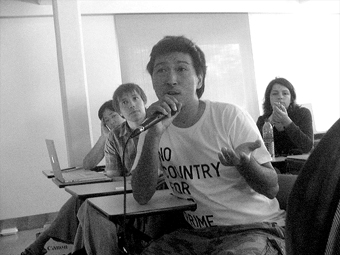 Noraset
also presented 'In the Dark', a video
installation in Thermocline of Art:
New Asian Wave, ZKM. Here a miniature
landscape is created through sculptural form and a human presence is
demarked through the use of video projection. This work again
questions our notions of reality, our own mediated being and the
boundaries or confines of technology.
Noraset
also presented 'In the Dark', a video
installation in Thermocline of Art:
New Asian Wave, ZKM. Here a miniature
landscape is created through sculptural form and a human presence is
demarked through the use of video projection. This work again
questions our notions of reality, our own mediated being and the
boundaries or confines of technology.
His interest in media first began when he was studying fine art, he began to explore the history of media art and its development in Thailand. However he states: “Although I work in media and installation arts, I wouldn't say I am a media artist. I simply try to work as sincerely as possible; I think that's how art should be.”
Noraset is aware that a young generation of artists are exploring the potential of interactivity etc., but also feels that they are working in isolation from each other and often not studying the actual system of the technology, often relying on a technician for this. He stresses the difference of education determines the ease and method of use of technology and calls for a new approach to inform people further about the implication of technology systems.

preeyachanok ketsuwan

Preeyachanok graduated from Department of Traditional Thai Art, Faculty of Painting Sculpture and Graphic art, Silpakorn University and focuses her practice upon media art, feminism and community, providing a commentary on contemporary social issues.
She has made detailed studies into the perceived female role in Thai traditional culture and the transmission of these values from one generation to the next. She has explored these ideas through sculptural, performative and video elements. An example of her early investigations involves reference to traditional Buddhist texts which represent female sexuality as exploited and suppressed by men, in particular in the tale of Naree Phol - the tale of women fruit in the Himmaphan forest.
With regard to Buddhist meaning, these shaman are seen as demon, and Women Fruit are symbolized as sexual emancipation.
She explores the continuing pressures of female culture from a young age which demand that girls stay at home and do housework while boys can go out and play with their friends. Freedoms and restrictions of gender are clearly marked from a young age which Preeyachanok describes as 'a cause of limitations in many women’s beliefs and ways of living'.
She has created a body of work based on the image of the maternity dress which she uses as a symbol of women’s roles and responsibilities expected from social and cultural points of view.
In these works she also employs hair with a dual meaning, firstly referencing the Buddhist scriptures in which hair is presented as an obstacle. In an act which symbolized his rejection of worldly attachments the Buddha shaved his head before leaving his palace, his wife, child and riches in search of enlightenment. As a result, hair in Buddhist terms is seen as a form of karma in connection with male desire and pleasure. Secondly, in the modern sense, hair has become a representation of beauty, good health, and social status. Preeyachanok comments 'Hair in my work represents two opposite implications fighting against each other. As a result my work expresses conflict, pressure, and mystery that many women have encountered on a regular basis'. In her latest video work she is depicted with her mother making maternity dresses and attaching hair to them, implying that female cultures have been passed down from one to another generation without being questioned.
She has also been engaged in a number of community projects working with children in slum areas and victims of Aids/HIV,
“One Book One Story” in Wat Kae-Nang-Leang slum. I encouraged children to narrate their lives through paintery diary.
My latest project with a group of friends entitled “One Scene in My Memory” is a continuation of “One Book One Story”. I encouraged the children in this slum to explain their love towards their community and problems /that they are facing through paper-doll making.
bug


BUG, Bangkok University Gallery, was established 10 years ago by the son of the founder of university and dean of university. It began in a converted classroom, but 2 years ago a new building was realized especially for the gallery. The focus of the gallery is upon contemporary art for educational purpose, along with a support for local, national and international artists and developing its international scale. They have developed a particular program to promote new artists called ‘Brand New’ to introduce emerging artists to the wider public. They have also encouraged exchange of cultural perspectives and diverse experiences by inviting international curators to present projects of both local and international artists. The gallery has also been involved in outreach projects working with rural villages in an examination of social conditions in these areas and the role that art may be able to provide in this. BUG is designed as a space for learning, discussion and network, which can further contemporary arts practice and theory in Bangkok.
the art center, chulalongkorn university

This vast gallery on top floor of the university library has recently been renovated and provides an excellent space for contemporary art exhibitions. The Art Center is committed to supporting contemporary arts both within and beyond Thailand and has likend itself to a laboratory in which cutting edge experiments can take place in new forms of innovation. It is currently promoting a highly multi-disciplinary approach to the arts, and while continuing to present traditional art forms, is encouraging collaboration between scientists, technologists, historians and artists to realize projects in new media and intellectual questioning.
bangkok experimental film festival (beff)

BEFF is a platform for experiments in film, video, animation and moving image which gives exposure to emerging creative practitioners, alongside more established artists and film producers. The festival showcases talent from both Thailand and surrounding Asian countries. The event this year consisted of exhibitions, cinema screenings and outdoor projection. This program was then toured around other parts of Thailand, South East Asia and Australia.
Australian based David Teh curated the festival program
BEFF was established by Project 304, an independent organization promoting contemporary and time-based arts in Bangkok and wider Thailand. It previously ran as a gallery and community space but now focuses on its organizational role
collaborating with local and international groups
bring greater awareness and appreciation of the contemporary arts to society at large.
white space

White Space is an artist run initiative based actually in a shopping mall in one of the most popular shopping districts amongst young people in Bangkok. It runs a regular program of exhibitions, artist talks and performances throughout the year. It is a key alternative space in Bangkok and has done much to promote a community amongst artists offering them a space to come and share ideas. Every month they run an open session where local and visiting creative practitioners can present about their projects and gain feedback from the audience.
http://www.whitesp-ce.com/gallery/
apichatpong weerasethakul

Apichatpong Weerasethakul is one of Thailand's most famous independent film makers. He has built up an impressive career with international recognition and also done much to support emerging talent in contemporary, film and video arts. I attended a presentation which he made at the Jim Thompson House library, in which he provided an overview to his film practice.
A recent work which I personally find movingly poetic is Morakot (Emerald), a single channel video installation filmed in the derelict building of a hotel. Established in the 1980s, at a time of great economic growth in Thailand, the hotel is taken as a symbol of casualties of the Asian bubble. The film pans through deserted rooms of old stripped beds which the air is filled with slowly floating feathers which sparkle in the light. Apparitions come and go in these spaces, recollecting memories of happier times.
sathit sattarasart

Olan Netrangsi, Pathompon Tesprateep, and Sathit Sattarasart are artists with an independent practice who have also come together as a collective "yield", in order to support experimental practices between contemporary art and new media.
I met with Olan and Sathit as they were just preparing for their exhibition ‘Will not cry in public’ presented at Chulalongkorn University. We discussed what role they saw media playing in Thai society and how they were attempting to respond to this in their works. They commented that they were interested to generate more media critique in a society which they feel the power of the mass media is too strong and which can lead to effective brainwashing.
This has led Sathit Sattarasart in particular to investigate the relationship between text and image and how this can be manipulated. His work encompasses writing, photography, installation and video, throughout which the written word is central to his practice.
In his video work ‘Breeze’, which was broadcast on national television, images of trees are overlaid with text which appears as if writing on a computer, overlaying nature with an annotation of technology. It tells a story of two people in transit at an airport, a conversation in which both are waiting for something. To be in transit is to be in a state of limbo, with no connection to your location, separated from the outside world by a concrete/glass encasing and a ticket to somewhere else. The work comments upon a time of uncertainty, concerning the invisible but fundamental problems of globalization, of conflict and morality. In relation to this work he discusses the role of media in promoting conflict and refers to the Vietnam war as an example of the power of the media, its exploitation of meaning which emerges from the combination of image and text and the manipulations these can be subject to.
His work ‘Drift’ , an installation in a hotel room, continues this equation of expectation and uncertainty. The audience is brought into a private space made public, yet the hotel is also a transient space, it may be our private space for some short time, then it becomes another's private space. Through the use of letters, video, sound and text installed in the room he retraces the fleeting presences of past occupants in a mix of fact and fiction, uncovering the memories which 'are still there like ghosts haunting the place'.
Other works include:
Space, a video work which juxtaposes images of residential buildings, sky, and abandoned spaces in Bangkok commenting upon the ever expanding city, the constant need for more space and the difficulty of the urban dweller to find a reflective space of their own.
Alienate in the big city – this video work comments upon the constant presence of technology in the urban space, which functions to objectify, control and alienate the human presence. The video mimics cctv in which the artist documents from various angles spaces along his daily movements presenting the video rendered lives of the urban population.

olan netrangsi
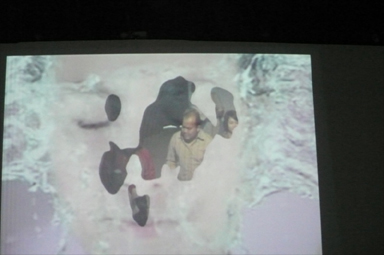
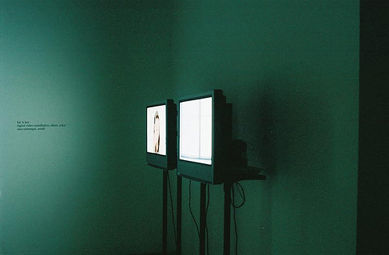
Olan is also highly engaged in questions of the authority of mass media and the daily reception of propaganda, challenging the accuracy and reliability of information which one is constantly subject to. He argues that there is a general lack of awareness with regard to the media's heavy regulation of society. The commercial media is a form of entertainment in which images of perfection are presented to us as representations of reality, a world that we must enter through active consumption. A recent work in the form of an interactive installation mixes live footage of the audience with that of television advertising, in which the viewer becomes entrapped in the image of the media and only through their action can they dispell this mirage and assert their own presence. He asks the audience to consider how can we resist media strategies and avoid becoming a victim of these.













